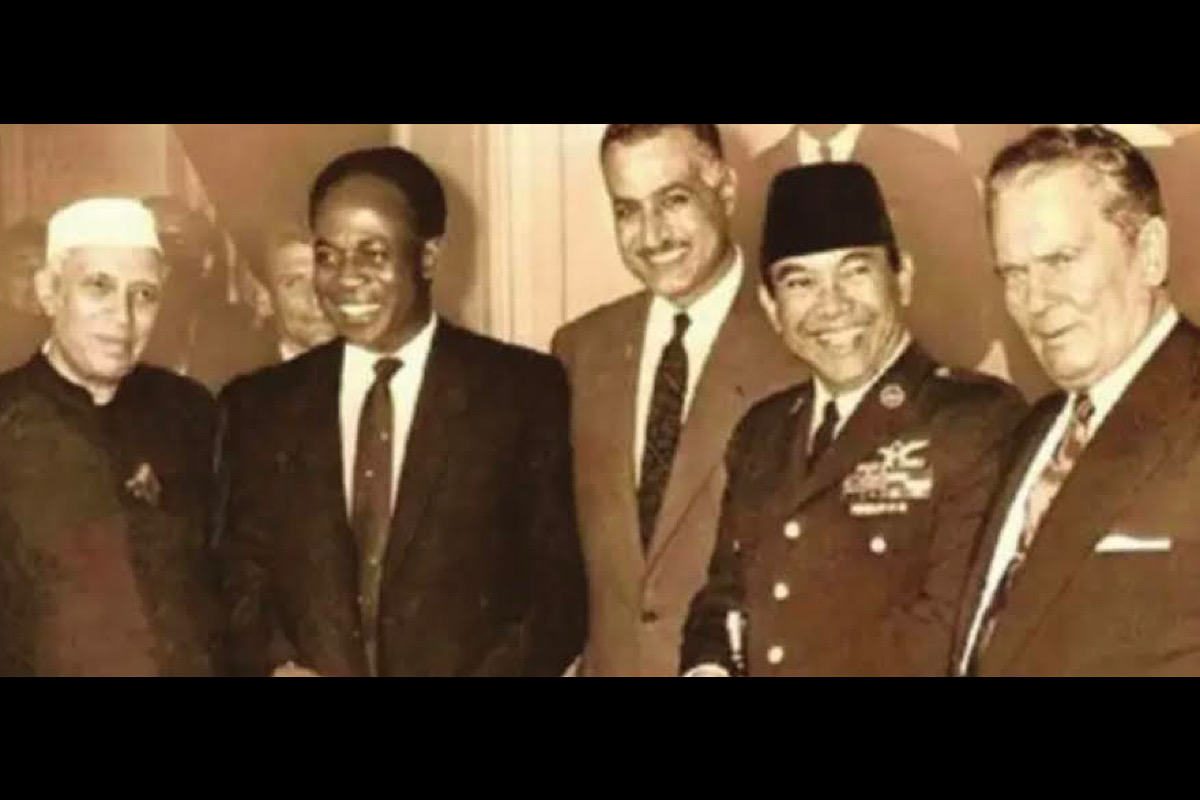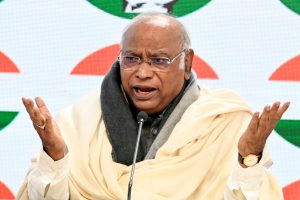The non-aligned movement originated in international politics from a group of states that shared the peacetime policy of avoiding political or economic affiliations with the major power blocs. At the beginning, the non-aligned movement consisted primarily of Asian and African states that were once colonies of the Western powers and were wary of being drawn into a new form of dependence by the West or by the communist bloc.
Founded by Jawaharlal Nehru, Gamal Abdel Nasser of Egypt and Sukarno of Indonesia, the basic concept of non-alignment originated in 1955 at Bandung, Indonesia. It was the first Afro-Asian conference that set out to promote concerted economic and cultural cooperation and oppose colonialism. Twentyfive countries attended the conference.
It affirmed the right to independence and to neutral coexistence in the Cold War between the East and the West. The movement mandated seeking development assistance from both the US and the Soviet Union while refraining from forming political or military alliances with either country
The first conference of the non-aligned movement (NAM) took place in Belgrade, in September 1961 under the leadership of Josip Broz Tito of Yugoslavia. Apart from the three leaders of the Bandung conference, Kwame Nkrumah of Ghana complemented the leadership making it five. The selection of Belgrade as the first venue of the conference deserves a mention.
As premier and president of Yugoslavia, Tito developed an independent form of socialist rule in defiance of the Soviet Union. He pursued a policy of non-alignment, built ties with other non-aligned states and improved relations with the western powers. President Tito displayed courage to defy USSR. During the Cold War era, NAM played a vital role in stabilizing the world order and preserving peace and security. Non-alignment did not mean neutrality of state on global issues; it meant peaceful intervention in world politics.
The towering presence of Nehru, then Prime Minister of India, as one of the founder members was highly visible in framing the policy of nonalignment. Principles of NAM were largely guided by Panchsheel, the five principles of peaceful coexistence enunciated in the agreement between the Tibet region of China and India signed on 29 April 1954. Of the five, three principles were included in the nonalignment document. They were a) respect for sovereignty, sovereign equality and territorial integrity of all states, b) respect for the political, economic, social and cultural diversity of countries and peoples and c) promotion and protection of multilateralism and multilateral organisations as the appropriate framework to resolve, through dialogue and cooperation, the problems affecting humankind.
The policy of nonalignment revealed a glorious and glittering history of post-World War II India. Independent India born out of partition was looking for a strong foundation to enrich and strengthen liberal democracy in the crisis ridden world devastated by the war. For a poor country that just achieved independence, it was an arduous task to maintain sovereignty and strengthen democracy and at the same time maintain international neutrality.
It is not that easy in today’s world to understand and comprehend the importance and significance of non-alignment that India pursued and adopted to make the country prosper seventy years ago. In spite of many frustrations, many denials, many failures and many errors, India continued to follow the principles of nonalignment.
India achieved unique distinction on the world stage to take its nascent democracy to new heights by keeping equidistance in the bi-polar world. Nehru’s charismatic personality, his political sagacity, his acceptability as a great leader of the country along with his position and prestige in the world contributed greatly to India’s strength in world politics. India’s backwardness, poverty, underdevelopment and poor military strength did not matter. It was recognition of India’s civilisation, tradition and culture. India under Nehru’s leadership set a unique example in the world by following the principles of non-alignment. Later many Asian and African countries after attaining independence emulated India’s policy. Many experts had commented that India’s foreign policy was at its best during that period. India being a founder and the largest member in NAM was an active participant in NAM meetings till 1970. India’s inclination towards the erstwhile USSR created confusion in smaller members. It led to weakening of NAM and small nations drifted towards either US or USSR. India skipped the 17th NAM summit held in Venezuela in 2016.
Very recently, India has received another honour. It will be the leader of G-20 countries for one year. The G-20 summit is held annually under the leadership of a rotating Presidency. India holds the Presidency from 1 December 2022 to 30 November 2023. It is the first ever G-20 summit to be hosted in India and also in South Asia. Brazil will take over from India to host the next summit. The G-20 is an intergovernmental forum comprising 19 countries and the European Union. It is composed of most of the world’s largest economies including both industrialised and developing nations. These nations represent around 85 per cent of global GDP, over 75 per cent of the global trade, about two-thirds of the world’s population and 60 per cent of world’s land area. Initially the objective of the G-20 was to create a new financial architecture to achieve global economic stability and sustainable growth. This was considered necessary by the industrialised nations and developing economies in the wake of 1999 Asian financial crisis followed by another global economic and financial crisis of 2007.
The G-20 group was designated the “premier forum for international economic cooperation”. There are six Asian countries in this group of twenty. India is one of them. The other five are China, Indonesia, Japan, Saudi Arabia and South Korea.
India is a major developing economy and has a vital stake in the stability of the international economic and financial system. India has been setting ambitious targets to keep infrastructure investment on track and also put in place problem resolution mechanisms to overcome implementation bottlenecks. In the modern world, economic growth and military strength are the two determinants of power equation.
On these two factors, India is marching forward. India is a nuclear weapons power and has for all practical purposes, abandoned the call for global nuclear disarmament. In foreign policy, India’s joining the Quadrilateral Security Dialogue, a coalition seen by many as a counterforce to China’s rise in the Indo-Pacific and getting membership of the Shanghai Cooperation Organisation led by China shows India’s balancing approach in the new global order. While taking over the Presidency of G-20, Prime Minister Narendra Modi said, “India’s G-20 Presidency will work to promote the universal sense of oneness. Hence, our theme ~ One Earth, One Family, One Future”
PIB, Mumbai in a press release said, “India is deeply committed to democracy and multilateralism. India’s G-20 Presidency would be a watershed moment in her history as it seeks to play an important role by finding pragmatic global solutions for the well-being of all and in doing so, manifest the true spirit of ‘Vasudhaiva Kutumbakam’ or the ‘World is One Family’.”
The agenda of G-20 now goes beyond macro-economic and financial stability. The expanded agenda includes trade, sustainable development, health, agriculture, energy, environment and climate change. In international law, almost all these functions fall under the jurisdiction of United Nations. There are numerous multilateral treaties on these subjects and agencies to implement them. Twenty countries composing G-20 cannot be the arbiter and decision making authority on collective security, responsibilities, commitments, strategies and institutions.
Overlapping responsibilities in international relations and global order should stop and the implementation of these subjects should remain within UN domain. India’s leadership in the G-20 summit this year and India’s leadership of non-alignment seventy years ago reveal contrasting pictures. G-20 presidency is by rotation. It is for a year. This is a common practice in international relations. Two days’ summit conference cannot change the world for the better. India’s turn will come next after many years. However, India has achieved this status as a developing country, one among the twenty. No doubt this is a great achievement. As against this, India’s leadership on non-alignment was original and everlasting. It had no parallel. It cannot be replicated. It cannot be duplicated. India attained that status as a poor country, just free from the shackles of foreign yoke. That was a wonderful and glittering history of which all Indians should be proud.
The writer is a former central civil service officer who retired from the Ministry of Defence










